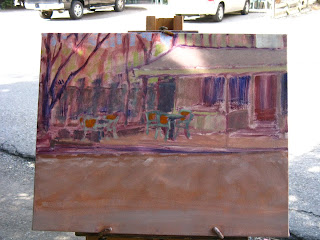My first paintings were done outside. At the time I had no idea why. The painter who got me into painting was trained that way so that is what I did too. Now I understand some of the reasoning and I feel that I have to paint en plein air for regular tune ups at least weekly, rain, snow, wind, and sun. It is like getting regular exercise so your body is fresh, strong, and supple for other activities.
Here are some of the truths gained by observations while painting in the great out door studio.
1. Mother Nature designs in irregular patterns, lines, light and dark patterns, and shapes. This is contrary to man who lays tile and bricks and everything else in regular symmetrical patterns. Boring.
2. Studying colour outside will show you how they work together. You have to learn to see what is actually there, not what you think is there.
3. There is lots of "stuff" there. Can be overwhelming. Cannot be copied. One must learn to simplify and design for interest. Each line and shape that makes its way into the drawing must be interesting before the painting begins. If not, its too late.
4. There is a lot of blue in the distance.
5. Yellow fades out quickly as you look into distance. Darks are often darkest in mid distance. Look at the value patches across a road as the road moves away from you.
6. Facing the sun, or otherwise keeping the palette, your eyes and the painting surface in the shade helps with keeping the darkest darks not too dark. Wear a brimmed cap to help. There is a lot that can be expressed in the shadows.
7. Your setup must be comfortable for you. Sitting, standing.......
8. A finished painting is not the usual en plein air. You should get a design (installed not observed), shapes, lines, colour notes including temperature, values, edges, and paint quality. At least indications of these. This information can then be used in the studio to finish.
9. Although you may not get a finished painting, you will get training regarding design, shapes, values, and colours. Work at it and you will learn to "see".
10. Reserve darks, lights, and chroma. This will allow for a few finishing strokes that make the painting come alive.
11. Make every piece of your gear count. Brushes, paint, easel, canvas, sun protection, drinking water.......... Some of my favourites are an egg timer, camera, peaked hat, coffee mug.
12. See the red in those greens. Modify.
Yesterday we came upon this birch in its surrounding. Can an interesting composition be made for it?
Grey Sky, Courtesy of Irene












